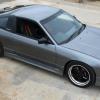S15 Turbo Discussion
Announcements
-
Similar Content
-
Latest Posts
-
I don't really know general street pads too well, but there is no reason you can't get a low dust, long wearing, no squeal pad that works for those calipers at a reasonable price....they would just be a low end to medium price daily style pad. If new pads don't have much bite or they loose it over time, it is probably just the pad glazing up which you can fix by giving them a good thrashing every now and then (or get the mechanic to deglaze them at next service) Track or semi track pads are where you have to put up with excessive dust (and potentially squealing as a side effect of that) in return for good bite and performance when very hot. Street pads have nothing like that sort of punishment, even long downhills with the brakes on are easier than a track session
-
lol yeah I'll check that, reminds me of the LDV thread! I don't think that is the problem here, the starter doesn't even solenoid click. I did do a super quick test by removing the starter motor's power cable from the engine bay fuse box and the battery voltage was still 10v, so something super fishy is going on. BTW here is a R33 fuse box table I threw together from a few sources....use at own risk! R33 Fuse Box and Sources.xlsx
-
By Dose Pipe Sutututu · Posted
Johnny's approach, throw all the Nissan electronics into the trash. Best thing I've done to my shit box, go DBW. -
By Dose Pipe Sutututu · Posted
Sounds like the JAX guys must have installed some really awful pads, are they BenShit/BenDicks pads by any chance? -
Result of another R35GTR build. Similar specs as above except this is running our bigger size SS-2 profile option. Made similar power except this car runs on Pump 98 fuel. Build specs are: Nissan R35 GTR 2015 model stock engine and box. ETS street intercooler boost logi intercooler piping with tial bov, boost logi turbo inlet pipe ID 1050 injector DW 300C fuel pump Decatted oem down pipe and y pipe& HKS exaust 3inch intake pipe Upgraded actautors HyperGear SS-2 high flow option Final result is 639whp / 477wkws hubs, Ron 93 / P98 fuel at 20psi.
-






Recommended Posts
Create an account or sign in to comment
You need to be a member in order to leave a comment
Create an account
Sign up for a new account in our community. It's easy!
Register a new accountSign in
Already have an account? Sign in here.
Sign In Now